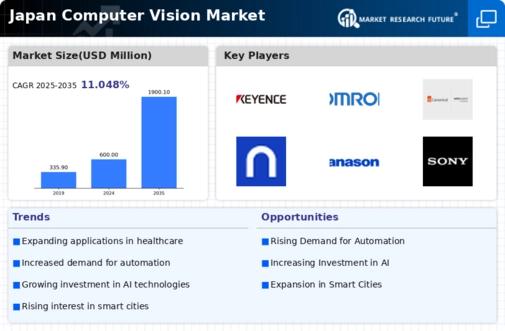Growing Adoption of Smart Devices
The proliferation of smart devices in Japan is significantly influencing the computer vision market. With the increasing integration of cameras and sensors in smartphones, tablets, and other consumer electronics, there is a heightened demand for computer vision applications. This trend is evidenced by a 40% increase in the use of augmented reality (AR) and virtual reality (VR) applications, which rely heavily on computer vision technologies. As consumers become more accustomed to these advanced functionalities, businesses are compelled to adopt computer vision solutions to meet market expectations. Consequently, the computer vision market is poised for substantial growth, driven by the widespread adoption of smart devices and the need for innovative applications.
Advancements in Deep Learning Algorithms
Recent advancements in deep learning algorithms are playing a pivotal role in shaping the computer vision market in Japan. These algorithms enhance the ability of machines to interpret and understand visual data, leading to improved accuracy in applications such as facial recognition, object detection, and image classification. The implementation of these sophisticated algorithms has been linked to a 25% increase in the performance of computer vision systems. As organizations seek to leverage these technologies for competitive advantage, the demand for advanced computer vision solutions is expected to rise. This trend indicates a robust growth trajectory for the computer vision market, with investments in research and development likely to further accelerate innovation in this field.
Rising Demand for Automation in Industries
the computer vision market in Japan is witnessing a significant increase in demand for automation across various sectors., including manufacturing, logistics, and healthcare. This trend is driven by the need for enhanced efficiency and accuracy in operations. For instance, the integration of computer vision technologies in manufacturing processes has been shown to reduce error rates by up to 30%, thereby improving overall productivity. As industries increasingly adopt automated solutions, the computer vision market is projected to grow significantly, with estimates suggesting a compound annual growth rate (CAGR) of around 20% over the next five years. This shift towards automation not only streamlines operations but also addresses labor shortages, making it a critical driver for the computer vision market in Japan.
Supportive Government Initiatives and Funding
The Japanese government is actively promoting the development of advanced technologies, including computer vision, through various initiatives and funding programs. These efforts aim to bolster innovation and enhance the competitiveness of Japanese industries on a global scale. For instance, government-backed funding for research and development in AI and computer vision technologies has increased by 30% in recent years. Such support is likely to accelerate the growth of the computer vision market, as it encourages startups and established companies to invest in new solutions. This favorable environment not only fosters technological advancements but also positions Japan as a leader in the computer vision market.
Investment in Security and Surveillance Systems
The emphasis on security and surveillance in Japan is a significant driver for the computer vision market. With rising concerns over safety and crime prevention, organizations are increasingly investing in advanced surveillance systems that utilize computer vision technologies. These systems can analyze video feeds in real-time, enhancing the ability to detect suspicious activities and respond promptly. Reports indicate that the market for security and surveillance solutions is expected to grow by 15% annually, with computer vision playing a crucial role in this expansion. This focus on security not only benefits public safety but also drives innovation within the computer vision market, as companies develop more sophisticated solutions to meet these demands.



















Leave a Comment